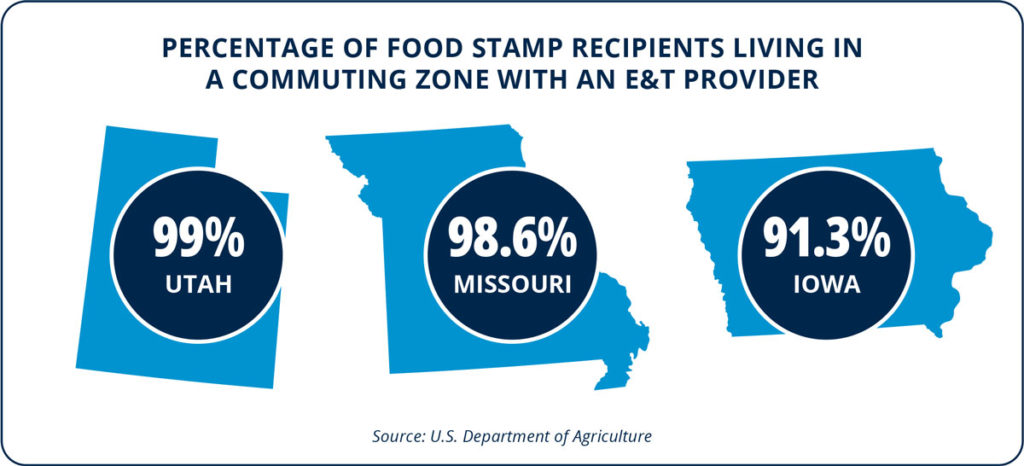Employment and Training Programs Are Within Reach of All Americans
KEY FINDINGS

THE BOTTOM LINE:
STATES SHOULD UTILIZE EMPLOYMENT AND TRAINING PROGRAMS.
Overview
With 11.3 million open jobs as of early 2022—a near-record high—businesses are in desperate need of workers.1 However, there are still nearly three million missing workers since the start of the pandemic.2
Thankfully, states have a powerful but often underutilized tool at their disposal.3 Through the general work requirement in the food stamp program, states may assign able-bodied adults ages 18 to 59 without small children to employment and training (E&T) programs.4 These programs offer a wide array of services and opportunities for Americans to search for work, pursue educational opportunities, improve their skill sets, and much more.5
Fortunately, not only do most Americans live in areas with E&T programs, but many states are now offering virtual programs to reach even more participants. Additionally, because there are so many different options for participants to choose from to satisfy the E&T requirement—from job search training to internships—the opportunities are truly endless, even in rural communities.

Individuals have numerous E&T options at their disposal
Work requirements in welfare programs are generally consistent: Able-bodied adults have to work, train, or volunteer at least part-time to continue receiving benefits.6 These work requirements have worked in other welfare programs, but the temporary federal suspension of the work requirement in food stamps has left a huge gap—one that assigning able-bodied adults to E&T programs would fill.7-9
One of the major benefits of E&T programs is their flexibility. Individuals have countless options to satisfy employment and training requirements, which allow them to meet this work requirement even in rural areas. Depending on the state, these options may include:
- Supervised job search: Participants apply for jobs, build connections, and attend hiring fairs or other networking events.10
- Job search training: Enrollees receive instruction and mentoring for job search activities, helping them to find work.11
- Workfare: Recipients work at a non-profit agency, helping them find work and contributing to the community.12
- Self-employment training: Enrollees receive training and assistance in setting up and running a small business or self-employment venture.13
- Job retention: For participants who have found employment through another E&T option, job retention helps individuals retain their employment, perform well at their job, and increase their earnings over time.14
- Basic/foundational skills instruction: Recipients can receive instruction for basic education skills below the college level, including basic literacy, adult-basic education, and high school equivalency programs.15
- Career and/or technical education programs or other vocational training: These activities offer enrollees the technical skills and know-how to prepare them for future employment opportunities, such as through trade certificates or associate programs.16
- English language acquisition: Participants for whom English is not their primary language can receive assistance in reading, writing, speaking, and comprehension.17
- Integrated education training/bridge programs: Recipients receive adult education and literacy instruction that runs concurrently with workforce training and preparation activities.18
- Work activity: A training program that offers individuals the knowledge and skills to find employment, with clear goals to increase employability.19
- Work readiness training: A set of intensive programs that provide educational remedial services and skills assessments to prepare individuals for the workforce.20
- On-the-job training: A contract that reimburses an employer or apprenticeship provider in exchange for offering on-the-job training to participants.21
- Pre-apprenticeship/apprenticeship: An option that combines on-the-job training with related instruction to give enrollees industry-specific knowledge that can help them carry out highly skilled work.22
- Internship: Recipients can participate in planned and structured learning in the workplace.23
- Transitional jobs: Participants receive work experience for a limited period of time, with the goal of achieving unsubsidized long-term employment.24
Additionally, mandatorily assigned enrollees are also required to participate in other essential E&T options, such as program orientation and an employability assessment.25
Of the 10 most rural states in the nation, every single one has more than one of the E&T options listed above, typically averaging four to six options per state.26 Most of these rural states offer at least one option across the entire state.27
Put simply, E&T is more than “work”—it includes a broad range of programs that allow individuals to find or retain a job, build their skill set, practice job searching, learn a trade, expand their education, and much more. Even in rural areas where there may not be plentiful “jobs” in the traditional sense, a wide array of E&T options are regularly available either statewide or in central locations. The broad scope of E&T options makes the program accessible to countless Americans, from urban areas to rural regions.
Most rural Americans live in areas with E&T opportunities
Not only are there several different types of E&T options that exist across the nation, but these opportunities are also widespread within rural states.
In many cases, states have designated E&T centers in high-population areas, or have third-party contractors and other partners that provide services to a broad region, such as community colleges, American Job Centers, Goodwill, and more.28
Equally important, in most rural states, there are E&T providers in most of the U.S. Department of Agriculture designated commuting zones (which are areas designated to identify local economies).29 As a result, these opportunities are widespread and easy to access.

Even in the rare areas of the country currently without widespread E&T providers, there are plans to scale up E&T programs. For example, Montana currently has providers in three different commuting zones, covering roughly 40 percent of Montanans on food stamps.30 However, by the end of the fiscal year, the state is expected to more than double the number of counties that have an E&T provider to eight—vastly increasing the percentage of Montanans on food stamps with easy access to an E&T provider.31 And in just a matter of years, the program will be statewide.32
States also reimburse some participant expenses—such as travel-related costs—for certain E&T options, further helping enrollees fulfill E&T requirements.33
Just as there are a wide array of E&T options, there are also countless providers across the country— including in the most rural areas.
States are using virtual programs to reach even more Americans
Even in the absence of on-the-ground locations, more and more states are utilizing virtual options to engage with food stamp recipients who are assigned to E&T programs. During the initial stages of the COVID-19 pandemic, several state agencies and partner organizations shifted their programs to make them accessible virtually—from Oregon to Massachusetts.34
And in some states, the program is administered almost entirely online. For example, in Utah, the state’s entire E&T program is virtual—however, 30 in-person locations exist to assist those in need of hands-on support.35 Idaho also contracts with a third party to administer the supervised job search option of its E&T program so individuals in all counties can participate.36
Potential participants have easy access to these virtual options. For example, an estimated 97 percent of Americans own cell phones, including 85 percent who own smart phones that enable them to access virtual E&T programs easily.37 Public libraries and other resources also provide a means for individuals to access the Internet.
Bottom line: States should utilize E&T programs.
E&T programs may be underutilized, but that is not because they are inaccessible. It is because states simply are not assigning individuals to them.
Potential program participants have access to a wide array of E&T options that could cover their individual needs, as well as physical locations in commuting zones of even the most rural states. Additionally, virtual options for E&T are becoming more and more widespread, opening up E&T opportunities to even more Americans.
E&T opportunities are out there. To bolster their workforce, states need to start assigning individuals to them.

REFERENCES
1. Bureau of Labor Statistics, “Job openings levels and rates by industry and region, seasonally adjusted,” U.S. Department of Labor (2022), https://www.bls.gov/news.release/jolts.t01.htm.
2. Author’s calculations based on the current civilian non-institutional population and the decline in the labor force participation rate since February 2020. See, e.g., FRED, “Population level,” Federal Reserve Bank of St. Louis (2022), https://fred.stlouisfed.org/series/CLF16OV; FRED, “Labor force participation rate,” Federal Reserve Bank of St. Louis (2022), https://fred.stlouisfed.org/series/CIVPART.
3. Hayden Dublois, “State employment and training programs are well funded—They just need participants,” Foundation for Government Accountability (2022), https://thefga.org/paper/state-employment-andtraining-programs-are-well-funded/.
4. Scott Centorino and Alli Fick, “The missing tool: How work requirements can reduce dependency and help find absent workers,” Foundation for Government Accountability (2021), https://thefga.org/paper/onetool-unleash-economic-recovery-solve-labor-crisis/.
5. Hayden Dublois, “State employment and training programs are well funded—They just need participants,” Foundation for Government Accountability (2022), https://thefga.org/paper/state-employment-andtraining-programs-are-well-funded/.
6. Food and Nutrition Service, “SNAP work requirements,” U.S. Department of Agriculture (2022), https://www.fns.usda.gov/snap/work-requirements.
7. Jonathan Bain et al, “Food stamp work requirements worked for Missourians,” Foundation for Government Accountability (2020), https://thefga.org/paper/missouri-food-stamp-work-requirements/.
8. Food and Nutrition Service, “SNAP – Families First Coronavirus Response Act and impact on time limit for able-bodied adults without dependents (ABAWDs),” U.S. Department of Agriculture (2020), https://www.fns.usda.gov/snap/ffcra-impact-time-limit-abawds.
9. Scott Centorino and Alli Fick, “The missing tool: How work requirements can reduce dependency and help find absent workers,” Foundation for Government Accountability (2021), https://thefga.org/paper/onetool-unleash-economic-recovery-solve-labor-crisis/.
10. Minnesota Department of Human Services, “SNAP E&T components and activities,” State of Minnesota (2021), https://mn.gov/dhs/assets/service-components-and-activities_tcm1053-444268.pdf
11. Ibid.
12. Ibid.
13. Ibid.
14. Ibid.
15. Ibid.
16. Ibid.
17. Ibid.
18. Ibid.
19. Ibid.
20. Ibid.
21. Ibid.
22. Ibid.
23. Ibid.
24. Ibid.
25. Ibid.
26. Information retrieved from FY2022 E&T state plan and contrasted with state population density figures from the U.S. Census Bureau.
27. Ibid.
28. Ibid.
29. Author’s analysis based on FY2022 E&T state plans and USDA commuting zones.
30. Information retrieved from Montana’s FY2022 E&T plan.
31. Ibid.
32. Montana Department of Public Health and Human Services, “Overview of DPHHS benefits programs,” State of Montana (2021), https://leg.mt.gov/content/Committees/Interim/20212022/Economic%20Affairs/Meetings/November%202021/Benefit-Cliff-Study-DPHHS-Programsummaries_final.pdf.
33. Minnesota Department of Human Services, “SNAP E&T components and activities,” State of Minnesota (2021), https://mn.gov/dhs/assets/service-components-and-activities_tcm1053-444268.pdf
34. Food and Nutrition Service, “Adapting SNAP E&T services for the COVID-19 pandemic and beyond,” U.S. Department of Agriculture (2020), https://www.youtube.com/watch?v=8HzC6YzbnRo.
35. Information retrieved from Utah’s FY2022 E&T plan.
36. Information retrieved from Idaho’s FY2022 E&T plan.
37. Pew Research Center, “Mobile fact sheet,” Pew Research Center (2021), https://www.pewresearch.org/internet/fact-sheet/mobile
